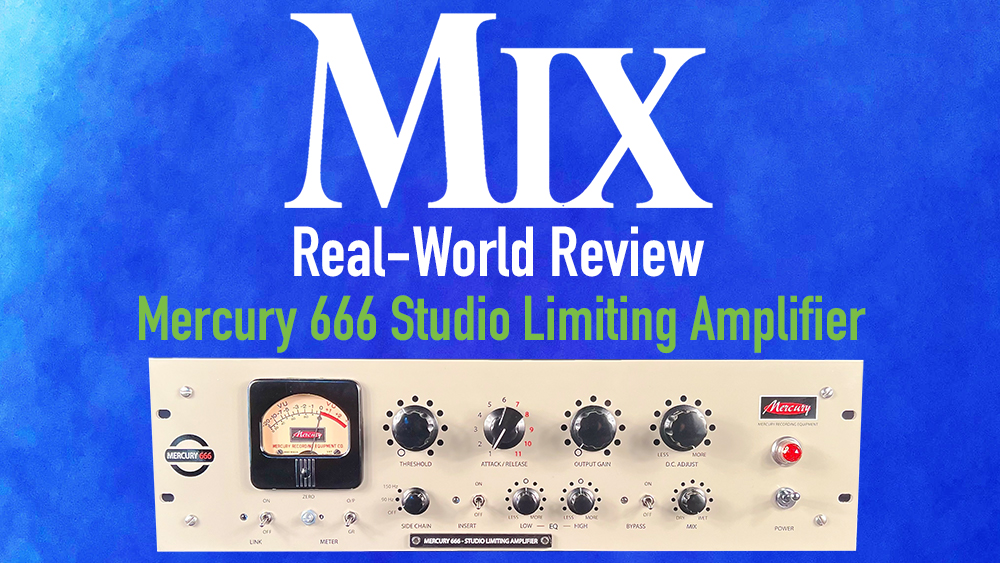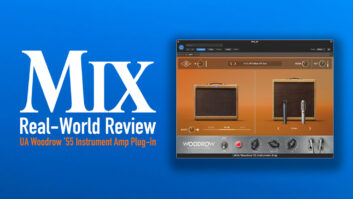
| MIX VERDICT: MERCURY 666 STUDIO LIMITING AMPLIFIER |
| THE TAKEAWAY: “Mercury’s 666 Studio Limiting Amplifier is devilishly good-sounding.” |
| COMPANY: Mercury Recording Equipment • www.mercuryrecordingequipment.com PRICE: $4,288 MSRP (Street Price: $3,888) PROS: • Wonderful-sounding compressor. CONS: • A bit of a learning curve. |
New York, NY (February 8, 2024)—Mercury’s 666 Studio Limiting Amplifier is devilishly good-sounding because it is based on the classic yet little known single-channel Fairchild 666 Limiter. Mercury’s David Marquette took care of a lot of the classic’s inherent limitations and quirks and went on to include modern design features to make it more flexible and allow it to operate like the variable-Mu Fairchild 660-670 limiters.
The 666 is a hybrid design and features a Baxandall equalizer with separate controls for adjusting the high and low frequencies. Placed after Mercury’s Solid-State Gain Reduction Element or SSGRE stage, these are very broad shelving equalizers, each two frequencies that track together at the same time.
The low frequency section has up to 10 dB of boost/cut at 20 Hz and also up to 5dB at 350 Hz. The high frequencies covered are: 20 kHz 6 dB and 2.5 kHz with 3 dB boost/cut possible. There is no bypass switch for the EQ section, but the straight-up, 12 noon position is flat.
Line-level audio comes into the SSGRE and also into the Dry side of a Wet/Dry mix control. Similar to parallel processing, a Wet Dry control is one of the unit’s modern touches never heard of back in the day of the Fairchild limiters.
The SSGRE’s exact gain reduction shape and operation is determined by both the inherent dynamics of the incoming audio signal itself, like any limiter/compressor, and also by the influence of the unique Sidechain/Insert section.
SIDECHAIN AND INSERT SECTION
The Mercury 666’s Sidechain and Insert section is an entire analog processing system in itself. The Sidechain has a switchable high pass filter with Off, 90, and 150 Hz choices—it is very smooth yet effective on most sources.
When the Insert is switched on using a small toggle switch, a bright red LED lights up and now audio coming out of the SSGRE goes out the rear panel’s XLR Insert Send jack to your external processor’s input (such as a parametric EQ or filter) with its output signal coming back into the XLR Insert Return XLR jack. The Insert is always available using the Insert On/Off toggle switch, which makes it useful in a live recording where you can have an additional compressor or EQ set up beforehand and ready to switch in at any time to handle a particular moment. This works very well, without any clicks or pops.
Although not required for regular operation, being able to further precondition the audio to be more specifically controlled is one of the main features of this totally analog unit. The Insert is useful for de-essing a vocal using a parametric EQ patched to the Insert.
FRONT PANEL
With the exception of the VU meter’s variable zero adjust control pot and the three-position sidechain HPF filter switch, all other controls are 11-position, ElectroSwitch rotary switches. The solid-feeling detents at each of the 11 positions have “dots” printed on the front panel for making recalls easy.
A single rotary control switch is used for selecting the Attack and Release times—Time Constants that are arranged in pairs of 11 preset combinations of fast, medium and slow attack and release times.
The unit comes with a list of these 11 combinations. The first six positions are the same as the vintage Fairchild 660, while the next five (indicated in red) are variants that expand the unit’s versatility.
At first, I rebelled at the idea I couldn’t tweak as usual to get these controls exactly where I wanted, but I grew out of that because the 11 positions are excellently thought-out and musical.
The attack times are fixed, with the fastest possible at 0.4 seconds and the slowest at 1.6 seconds. Release times possible range from 0.1 seconds to the slowest at a leisurely 10.7 seconds.
Apple Logic Pro 10.8 — A Mix Real-World Review
There are many dual-slope release times that emulate the old Gates Sta-Level in either singleor double-slope modes, as well as other vintage compressors and leveling amps.
All these timings are noted on a paper sheet that comes with the unit. I would love to see a (more) permanent list printed on a Mylar sheet that could be stored and pulled out from a slot at the bottom edge of the front panel.
Among other detailed information not possible to be silk-screened on the front of the Mercury 666, you would have instant access to verify the parameters of the particular Attack/Release combination in use. This sheet would stay with the unit and not get lost.
The front panel also has rotary switch controls for Output level adjustable from off to +30 dB positioned after the Wet/Dry control, so if you like to match output levels using the Bypass button method, this works out to be a good idea.
One quirk: The unit is in circuit and working when the Bypass switch is down. The up position is hard-wired Bypass. In Bypass, a super-bright red LED will light up to let you know.
IN THE STUDIO
Once you get used to the controls and basic operation, the Mercury 666 is extremely simple to use, with just a single, 12BH7 tube and a custom Cinemag transformer in the output stage. I especially liked the hardwire bypass switch as it directly connects the input XLR connector to the XLR output connector. Excellent parts quality is obvious when looking under the hood of the 3U steel chassis and cabinet. There are WIMA caps, gold pin XLRs, and a well-lit, custom Hoyt VU meter that reads both output level and gain reduction but not input level.
The Mercury 666 was made for those moments in the recording studio when getting a great sound quickly is the key to capturing the magic happening right in front of you.
I developed my own collection of presets I would use as starting positions, taking cellphone pictures and naming them according to their use. Once rough Threshold and Output settings are in play, I would “recall” any of the presets to try them quickly on vocalists, direct bass or acoustic guitars—all excellent sources for the Mercury 666. From there, I would tweak to taste, but actually most of my presets sounded pretty close immediately.
My first use was for a singer who sang with a smooth, almost angelic quality. I tried Attack/ Release #7, with the EQ flat, the 150 Hz HPF on, Threshold at 4 dots, and DC Adjust at 3 dots above the Less position at full CCW. Wet/ Dry was at 100% Wet. I was able to maintain the singer’s quality even with up to 6 dB of compression on peaks.
DISCOVERING DC ADJUST
From the one-sheet manual: “D.C. Adjust works similarly to DC Threshold on a Fairchild 660 limiter or DC Adjust on our Mercury 66. This controls the voltage that increases or decreases the actual starting point when/where the ‘compression’ starts: Less or more—start sooner or later.”
I came to understand that DC Adjust “fine tunes” the Threshold setting in a way that changes the character of the compression. With the control set toward CCW, or the Less position, my singer sounded more natural with good dynamics. As I turned the control CW toward the More position, my singer sounded “darker” and smoother, rolled-off, and more squashed. For most of my time with the Mercury 666, I generally liked this control set toward the Less side.
For a harder-sounding Rock female vocalist, my settings changed a lot. I wanted more compression while also maintaining clarity, if possible. Same #7 Atk/Rel, but much more compression at #8 dot on Threshold, with the Wet/Dry control at about 40% Dry. The EQ was max boosted at the low frequencies, and I was at 2 dots of high frequencies. Same HPF and DC Adjust settings.
Even with peak moments of over 10 dB of compression indicated, the Mercury 666 certainly brought the lead vocal forward in the mix without sounding overly compressed.
I could hear more of the subtle guttural and epiglottal sounds of her voice easily even though she was singing very loud. Between Threshold, DC Adjust and Baxandall EQ, and the Wet/ Dry control, there are many sonic possibilities for compressing lead vocals with the Mercury 666—another classic-sounding compressor!







